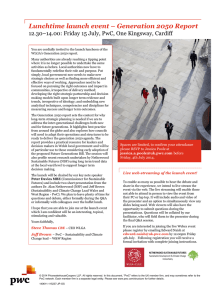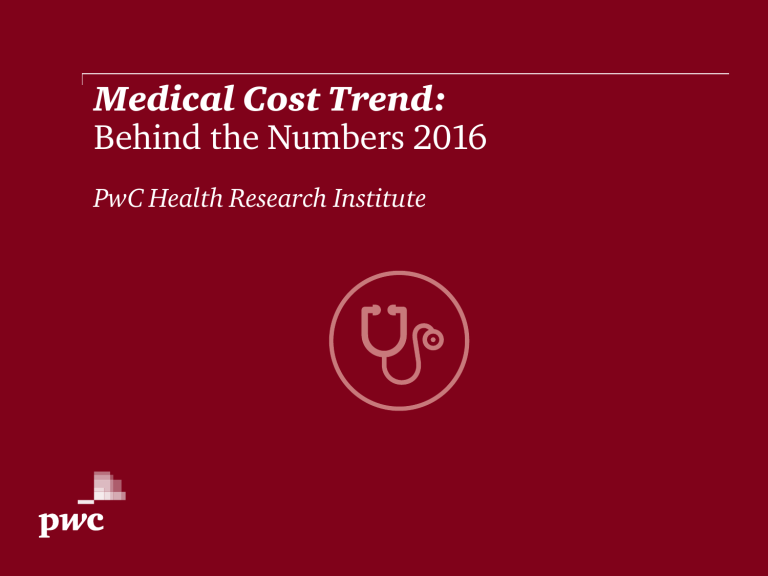
Medical Cost Trend:
Behind the Numbers 2016
PwC Health Research Institute
Although the health spending growth rate is slowing, it still
continues to be a disproportionately large part of the US economy
Year-over-year growth in national health expenditures adjusted for inflation and % of total GDP
12%
20%
NHE as a
% of GDP
17.4%
9%
6%
5.8%
10%
Trend
(%
3%
5.2%
NHE
grow
% NHE
Growth
th)
NHE as a % of GDP
% NHE growth
15%
5%
2.1%
0%
1961
1965
1970
1975
1980
1985
1990
1995
Source: National Health Expenditures data, Consumer Price Index data from Bureau of Labor Statistics, and
PwC Health Research Institute analysis
2000
2005
2010 2013
0%
PwC Health Research Institute
As cost-sharing increases, consumers forego care
Average employer insurance deductible vs. percentage of consumers foregoing care
$2500
45%
$2000
36%
% of US consumers that
forego medical care
29%
$1500
27%
$1,200
$1000
18%
In-Network Deductible
$680
$500
9%
$0
% of US consumers that forego medical care
Average in-network deductible ($/year)
40%
0%
2009
2010
2011
2012
2013
Source: PwC 2015 Health and Well-being Touchstone survey, Gallup Poll, and PwC HRI consumer surveys
2014
2015
PwC Health Research Institute
Inpatient care volume on a rapid decline
Changes in hospital inpatient and outpatient utilization
140
2,171
Inpatient admissions
per 1,000 people
120
Estimated projections
of utilization change
2,100
100
96
80
2,000
60
1,937
40
Outpatient visits
per 1,000 people
1,900
Outpatient visits per 1,000 people
Inpatient admissions per 1,000 people
120
2,200
20
0
1,800
2003
2004
2005
2006
2007
2008
Source: Source: American Hospital Association 2013 data and HRI analysis
2009
2010
2011
2012
2013
2014
2015
2016
PwC Health Research Institute
Most employers indicate ACA is not a major cost driver
Percentage of US employers that responded that the following ACA components have had a
significant financial effect on their business
36%
31%
25%
24%
16%
4%
Reporting and
compliance
requirements
Large employer
reporting for
employer shared
responsibility
Source: PwC 2015 Health and Well-being Touchstone survey
Excise tax on
high-cost plans
(Cadillac Tax)
Reporting of
minimum
essential
coverage
Additional
fees and
taxes (PCORI
and
reinsurance)
Free rider
$2,000 penalty
per FTE
PwC Health Research Institute
Healthcare spending growth rate for 2016 is 6.5%
HRI’s projected medical cost trend over the years
11.9%
Behind the numbers
Medical cost trends for 2007*
PricewaterhouseCoopers’ Health Research Institute
9.9%
9.2%
PricewaterhouseCoopers’
Health Research Institute
9%
Medical Cost Trend:
Behind the Numbers 2016
9%
June 2015
Health Research Institute
8.5%
Behind the numbers*
Healthcare cost trends for 2008
Insert an image. Be
sure that the photo
allows legibility
for PwC logo and
Connected Thinking
mark. Delete this
note.
7.5%
PricewaterhouseCoopers’
Health Research Institute
PricewaterhouseCoopers’
Health Research Institute
Behind the Numbers*
PricewaterhouseCoopers’
Health Research Institute
Behind the numbers
Behind the numbers*
Medical Cost Trends for 2009
Medical cost trends for 2011
Medical cost trends for 2010
*connectedthinking
6.8%
6.5%
Behind the numbers
Medical cost trends for 2012
Health Research Institute
May 2011
Medical Cost Trend:
Behind the Numbers 2013
6.5%
6.5%
*connectedthinking
*connectedthinking
May 2012
Health Research Institute
Medical Cost Trend:
Behind the Numbers 2015
Medical Cost Trend:
Behind the Numbers 2014
June 2014
Health Research Institute
June 2013
Health Research Institute
2007
2008
2009
2010
Source: PwC Health Research Institute medical cost trends 2007–2016
2011
2012
2013
2014
2015
2016
PwC Health Research Institute
Employers offering only high-deductible plans
Percentage of US employers that have already implemented high-deductible plans as the only
option offered to their members
25%
25%
20%
17%
15%
10%
18%
The percentage of
employers offering
only high-deductible
plans for employees
has nearly doubled
since 2012.
13%
5%
0%
2012
2013
Source: PwC 2015 Health and Well-being Touchstone survey
2014
2015
PwC Health Research Institute
Cost-shifting pushes consumers to become more conscientious
about their healthcare choices
Percentage of consumers with employer-based insurance who took the following actions in
the last 12 months due to cost of care
28%
28%
24%
20%
18%
16%
Skipped seeing
a specialist
(such as an
OB/GYN,
dermatologist,
orthopedic
surgeon)
Skipped
follow-up
care (such
as going to
physical
therapy
sessions
recommended
by a doctor)
Skipped
seeing
a doctor
Source: PwC Health Research Institute 2015 consumer survey
Asked for
a generic
prescription
instead of
a brand
prescription
Skipped
prescription
medicine or
took less
medication
than prescribed
Delayed or
skipped a
procedure or
treatment
PwC Health Research Institute
Consumers with employer-based insurance are seeking more
affordable options
Asked a
doctor for a
cheaper
alternative to a
prescription
drug
Asked about an alternative
treatment because of costs
38%
None
62%
Asked a
doctor or
hospital for a
medical
discount
Asked a
doctor for a
less costly
alternative to a
healthcare
procedure
Appealed an
insurance
decision about
coverage or
amount paid
Contacted
hospitals for
payment
eligibility
assistance
Asked a doctor
for a referral to
a different
specialist due
to cost
Source: PwC Health Research Institute 2015 consumer survey
Contacted
doctors and
healthcare
facilities to ask
about price
PwC Health Research Institute
Diabetes management shows greater savings with the use
of virtual care
Illustrative comparison of annual diabetes costs for in-person treatment vs. virtual care
in US
Base Case (No Virtual)
Virtual Care
Utilization
per 100,000
individuals
Costs per
100,000
individuals
($ Millions)
Hospital inpatient days
193,011
$622 M
173,710
$560 M
-10%
Physician office visits
792,697
$158 M
673,792
$134 M
-15%
–
–
294,035
$15 M
–
ER visits
69,256
$71 M
62,330
$64 M
-10%
Hospital outpatient visits
79,160
$57 M
75,584
$54 M
-5%
$827 M
-9%
Virtual visits
Total
Source: PwC Health Research Institute analysis
$908 M
Utilization
per 100,000
individuals
Change
Costs per 100,000
individuals
($ Millions)
Percentage
PwC Health Research Institute
New health advisers are guiding consumers to affordable care
Comcast Corporation
Accolade:
• What is it? A high-touch concierge service that
provides consultative support to 95% of employees
who have claims
• How does it work? Very popular and highly utilized
service that helps employees find the most
cost-effective providers through the use of various
tools (such as Castlight and second-opinion tools) and
partnerships (such as MD Anderson)
• Results–In the past 5 years, utilization and
readmissions have steadily decreased
Fallon Health
Fallon SmartShopper tool:
• What is it? A tool that ranks providers based on procedure
codes and geography, and lists increasing financial incentives
(for example, $50, $100, $125) for employees
• How does it work? Employees receive financial incentives
towards a treatment if they choose
a preferred facility
• Results–Increased savings overall and high satisfaction rates
among employees who have used the service
Spendwell Health, Inc.
SpendWell e-commerce site:
• What is it? An online marketplace that allows
consumers to purchase routine care at known
prices by creating bundled health treatments and
services that are easily priced by providers and
consumed by shoppers
• How does it work? Providers select their services
and prices and are no longer required to verify
eligibility, benefits, or reconcile claims and
remittances, and are paid in real-time, making the
process a true e-commerce transaction
• Results–The marketplace simplifies health care
purchasing which results in savings of 9-20%
below health insurance negotiated fees
Source: PwC Health Research Institute research
Commonwealth of Kentucky, Kentucky Employee’s
Health Plan
Vitals SmartShopper:
• What is it? Vitals SmartShopper team conducts specific
outreach to members slated for certain procedures (such
as MRIs, colonoscopies, ultrasounds) and offers
alternative facilities
• How does it work? Both consumers and employers are
offered savings for using alternative locations
• Results–Radiology outreach program had 85% success
rate in ensuring employee chose preferred facility when
outreach was conducted and they were offered alternative
locations to conduct MRI
Honeywell International, Inc.
Surgery Decision Support:
• What is it? A tool that provides
employees resources for weighing
options when surgery is needed for
knee, hip, back, or hysterectomy;
bariatric surgery will also be added
in 2015
• How does it work? $1000 penalty
implemented for those who pursue
surgery but do not go through the
program
• Results–In 2013, employee
participation jumped to 92% from an
extremely low number the previous year
PwC Health Research Institute
Specialty drug approvals continue to race ahead
Specialty drug approvals have surpassed traditional drugs in the past five years, and based on
the FDA pipeline this trend will continue
Traditional drug approvals
2016 Estimated sales for top 7 of
700 specialty drugs are $9 Billion
Specialty drug approvals
Viekira Pak
(Hepatitis C)
$3B
lumacaftor plus ivacaftor
(Cystic fibrosis)
$2B
24
21
22
22
18
23
24
6
7
8
8
10
2005
2006
2007
2008
2009
17
9
12
14
2010
18
2011
22
2012
19
2013
27
2014
Opdivo (Melanoma)
$1.8B
Praluent
(Hypercholesterolimea)
$1.3B
Ibrance (Breast cancer)
$0.8B
evolocumab
(Hypercholesterolimea
/Hyperlipidemia)
$0.3B
Cosentyx (Psoriasis and
psoriatic arthritis)
$0.2B
Source: PwC Health Research Institute research based on data from the FDA, Express Scripts, Catamaran, and Thomson Reuters
PwC Health Research Institute
Health organizations are concerned about data breaches
What is the number of security incidents
detected in the past 12 months?
What is your organization’s total
information security budget for 2014?
When compared with last year, security
spending over the next 12 months will?
$49,999 or less
3.61%
0 or none
50 or more
15.00%
28.75%
Decrease
$50,000 - $99,999
4.82%
$1 million
or more
33.73%
$100,000 $999,999
28.91%
10-49
12.50%
12.20%
Stay the
same
25.61%
Increase
62.19%
1-9
43.75%
$1 million - $9.9 million
28.92%
Source: PwC Global State of Information SecuritySurvey 2015
PwC Health Research Institute
Providers have strong incentives to spend now on cyber security
to avoid high costs of future breaches
Estimated costs
of major breach
$200
per patient record
Preventive
cyber security costs
$8 per patient record
Prevention
• Risk assessment and
management
• Security controls
• Monitoring and detection
• Forensics and insurance
Source: PwC Health Research Institute analysis
Post-breach
• HIPAA fines
• Legal fees
• Lost business due to
reputational damage
• Customer restitutions and credit
monitoring services
PwC Health Research Institute
For more information, please visit:
www.pwc.com/us/healthindustries
www.pwc.com/hri
twitter.com/PwCHealth
Additional HRI publications:
The FDA and industry:
A recipt for collaborating
in the New Health
Economy
Medical Cost trend:
Behind the Number 2015
Published January 2015
Download
Published June 2014
Download
Top health industry issues
of 2015
Medical Cost trend:
Behind the Number 2014
Published December 2014
Published June 2013
Download
Download
© 2015 PricewaterhouseCoopers LLP, a Delaware limited liability partnership. All rights reserved. PwC refers to the US member firm, and may sometimes refer to
the PwC network. Each member firm is a separate legal entity. Please see www.pwc.com/structure for further details. This content is for general information
purposes only, and should not be used as a substitute for consultation with professional advisors. MW-15-1634



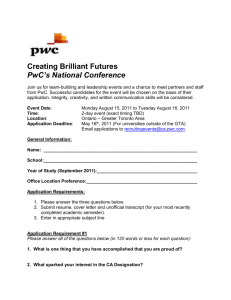
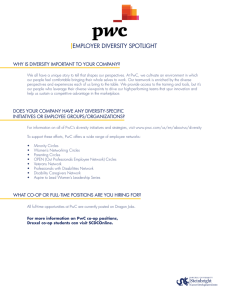

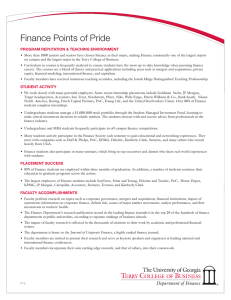
![(On client's letterhead) [Debtor] – [Address]](http://s2.studylib.net/store/data/015619376_1-634457b7baedfa32fb5e3856cbcd37b7-300x300.png)
